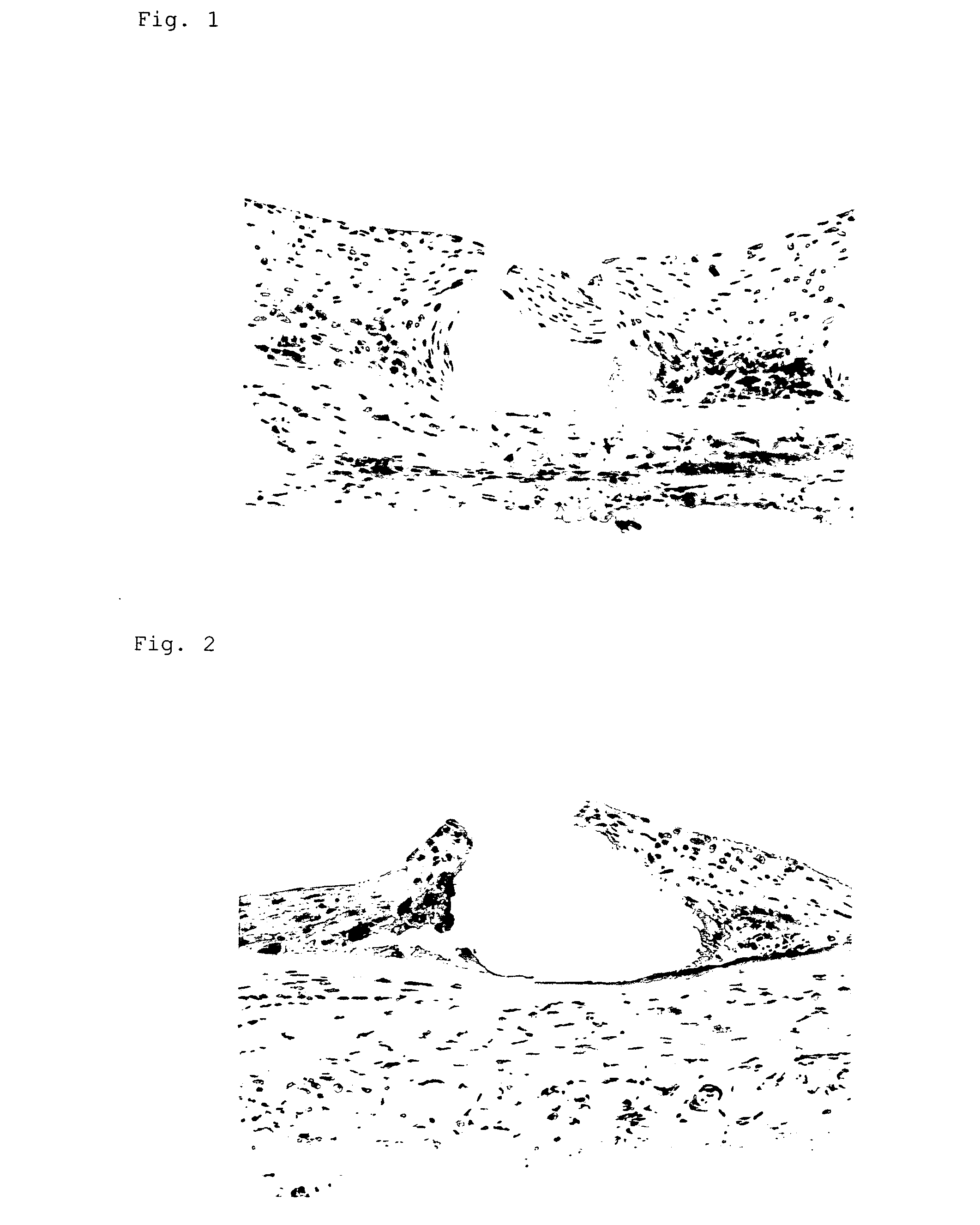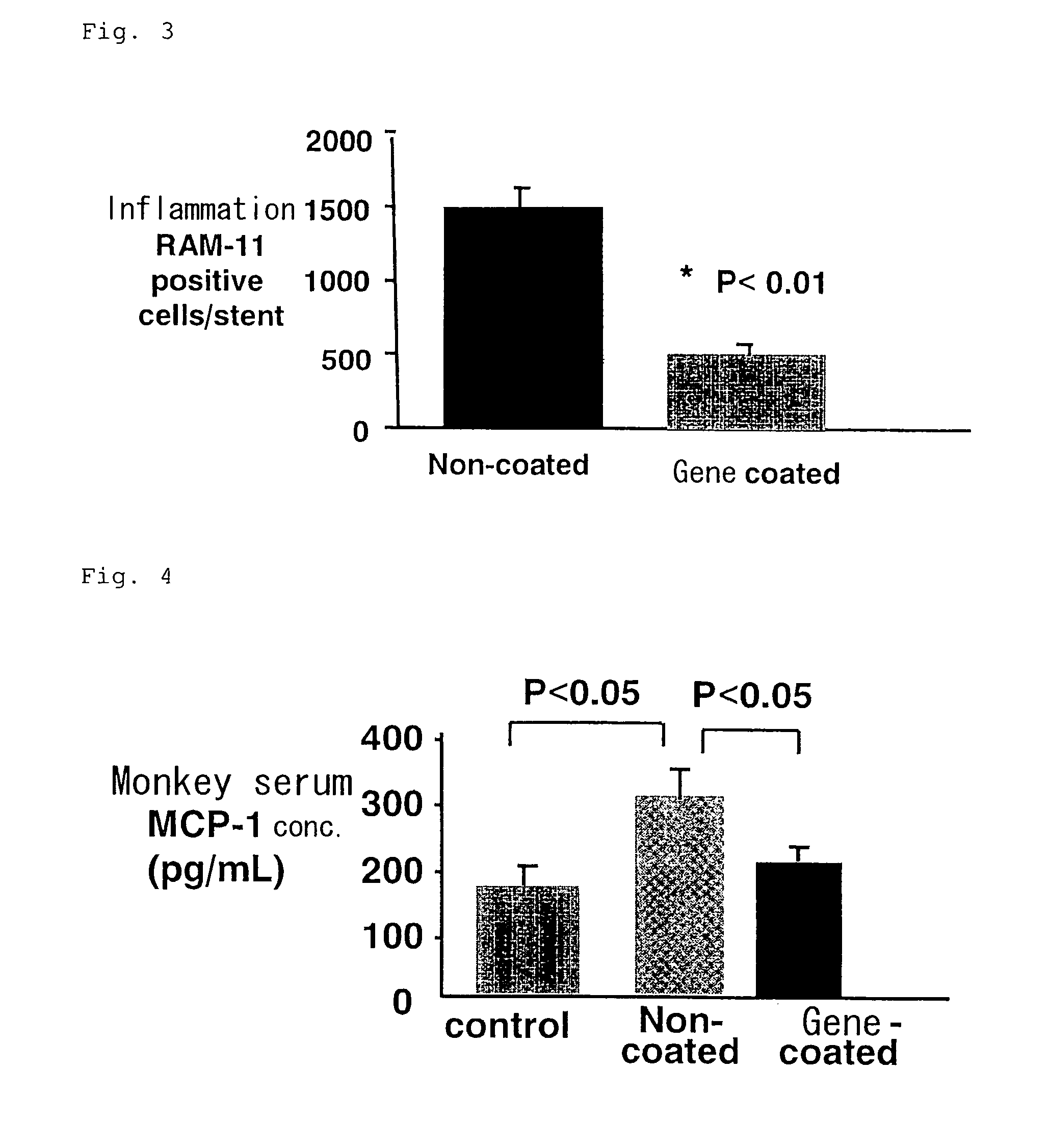Drug/gene eluting stent
a stent and gene technology, applied in the field of drug/gene eluting stents, can solve the problems of delayed endothelial regeneration, no established method, and high rate of “restenosis” or relapse of stenosis of once dilated cardiac arteries,
- Summary
- Abstract
- Description
- Claims
- Application Information
AI Technical Summary
Benefits of technology
Problems solved by technology
Method used
Image
Examples
example 1
Preparation of a Drug / Gene Eluting Stent
[0035] A drug / gene eluting stent with four layers structure was prepared by the following steps (1) to (4);
[0036] (1) A silane coupling agent was diluted in a methanol / water (volume ratio: 50 / 50), applied on an exterior surface of a stent with inner diameter of about 2.8 mm, and formed a primer layer after drying.
[0037] (2) A 2 mass % solution of a water absorptive polyether type thermoplastic polyurethane dissolved in tetrahydrofuran (THF) was coated on a primer layer and formed a drug layer base.
[0038] (3) The stent prepared by step (2) in an aqueous solution of a gene encoding a hybrid polypeptide at 10 mass % was dipped and thoroughly swelled. Thereafter, the stent was vacuum dried to remove water and formed a drug layer.
[0039] (4) A 2 mass % solution of a highly in vivo stable polycarbonate type thermoplastic polyurethane dissolved in tetrahydrofuran (THF) was coated on the drug layer to form a protective layer and the stent of the p...
example 2
Investigation of a Gene Expression and Inflammation Image in a Cholesterol Loaded Rabbit•Model
[0040] A stent (inner diameter of about 2.8 mm) coated with a gene encoded a marker gene, LacZ, was indwelled in an iliac artery of a hyperlipemic domestic rabbit loaded with 1% cholesterol for four weeks and investigated the gene expression after three days. Cells positive to gene expression were observed in 60-70% of intimal cells and 50% of medial and outer membrane cells. No positive cell was observed in a stent without gene coating. This was tenfold or over of the transfer efficiency compared to the result shown in Nat. Biotechnol., November 2000,; 18(11): 1181-4.
example 3
Investigation of an Inflammatory Image in Cholesterol Loaded Rabbit•Model
[0041] Metal stents (n=5) or gene-coated stents (n=5) (both have inner diameter of about 2.8 mm) were indwelled in an iliac artery of hyperlipemic domestic rabbit loaded with 1% cholesterol for 12 weeks. Determination of macrophage infiltration and blood level of monocyte migration factor, MCP-1, were performed after 10 days.
[0042] In addition, the gene-coated stent was prepared with the metal stent similar to that of the control, and a biodegradable base material containing a plasmid composed of a gene encoding FNCBD-7ND hybrid polypeptide in a similar manner with that of the preparation example.
[0043] Macrophage infiltration in arteries was searched using an antibody which specifically recognizes rabbit macrophage in histochemical investigation and a significant inhibition of the infiltration degree (p<0.01) was observed in the gene-coated stent group in comparison with that in the metal stent group.
[0044...
PUM
| Property | Measurement | Unit |
|---|---|---|
| Particle size | aaaaa | aaaaa |
Abstract
Description
Claims
Application Information
 Login to View More
Login to View More - R&D
- Intellectual Property
- Life Sciences
- Materials
- Tech Scout
- Unparalleled Data Quality
- Higher Quality Content
- 60% Fewer Hallucinations
Browse by: Latest US Patents, China's latest patents, Technical Efficacy Thesaurus, Application Domain, Technology Topic, Popular Technical Reports.
© 2025 PatSnap. All rights reserved.Legal|Privacy policy|Modern Slavery Act Transparency Statement|Sitemap|About US| Contact US: help@patsnap.com



